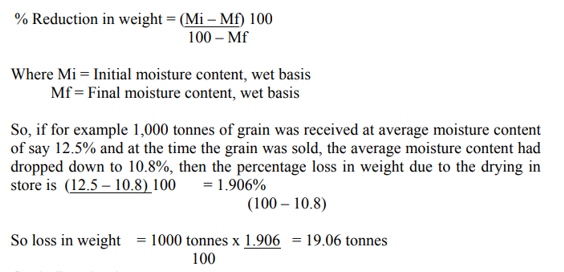There is no specific percentage for storage loss, but the declared loss should be within acceptable levels based on established local conditions. Factors which largely contribute to storage loss are grain shrinkage and insect infestation. Shrinkage refers to loss in volume in weight of grain placed in the bin and the loss is basically due to moisture reduction and respiration leading to dry matter loss.
Loss Due To Moisture Level Changes
Normally, grain in store continues to undergo natural drying and this is exhibited through difference in moisture content at intake and disposal. The loss in weight as a result of the drying process is given by the formula:

Losses Due To Grain Respiration
Grain respiration in dry grain is extremely low and so loss in weight due to metabolic activities is very low. For example, maize at 13% moisture content stored at 230 degrees Celsius loses 0.0675% dry matter in 100 days. Applying this to 1,000 tonnes for 2 years, for example, the loss in weight will be 4.94 tonnes. However, at SGR, since the grain is stored at maximum 12.5%, this loss will be much less.
Losses Due To Insect Infestation
Insect infestation Insect infestation will lead to loss in mass since insects eat away the germ and the endosperm. The degree of loss depends on the duration of attack, insect type and the kind of grain. With good quality and maintenance practice, this loss is not expected. However, there are different methods to estimate the loss in weight due to insect infestation should it occur. This includes:
Figures of 0.5 to 1.5% per month
Formula Li = 0.005 x 1d x Wi
(Where Li = Losses caused by insect damage in kg)
Id = % insect damaged kernels at the end of the storage period
Wi = Weight of incoming stock in kg
So, if 1,000 tones of good wholesome grain was stored for 2 years and at the time the grain was sold, the average percentage insect damaged grain was 7.0%, then,
the loss due to insect damage = (0.005 x 7 x 1,000,000) kg = 35.0 tonnes
Mass balance – from a sample, compare the weight of insect damaged grains with weight of equal number of whole grains. The difference in weight is due to the insect infestation. The percentage difference in weight can be used to establish loss in weight for the consignment.
Other Losses in Storage
Caking: This is not significant but whenever caked material is recovered, it must be borne in mind that the weight in kg of the caked material is less than the amount in kg from which was derived.
Mixing: In silo plants handling and storing different types of grains, leakages of one type of grain into another do occur if slides if gates are not functioning the way they should, and this can cause exaggerated shortage in one of the products.